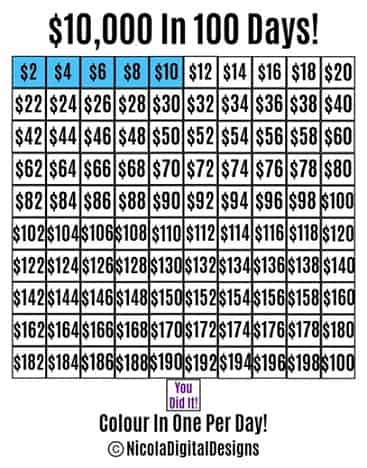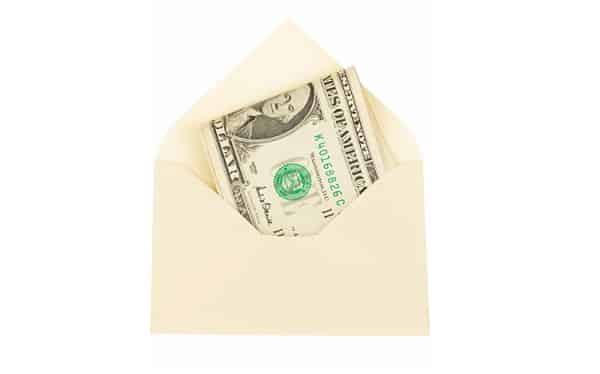What’s the 100 envelope challenge?
One way to save money quickly is to do the “100 Envelope Challenge,” which entails saving $100 every day for a hundred days. To make this system work, just number each envelope from 1 to 100. Every day, you choose an envelope at random and place the designated amount inside.
The 100 Envelope Challenge might help you save money by forcing you to create and adhere to a budget.
This approach to financial planning is not only practical but also enjoyable. It motivates you to think of innovative methods to make and save money so that you may get there sooner.
The 100 Envelope Challenge might be difficult since it involves strict budgeting and monitoring to guarantee real savings. It might be discouraging and lead to giving up if you don’t fill an envelope with money on certain days.
Also, not everyone has the financial flexibility to participate in the 100-envelope challenge.
$10k in 100 days challenge
The necessity to have $10,000 on hand at the end of the day is a major obstacle to saving $10,000 in 100 days using the envelope challenge. First, assess your available resources and cash flow before beginning the endeavor.

To begin this test, you will be provided with one hundred envelopes. You are to deposit $2 into the first envelope on Day 1, and $4 into the second envelope on Day 2.
The next day, on day three, you’ll place $6 in the third envelope. Do you see a trend here? The money you put in the envelope each day will grow by $2.
Is there enough money coming in that you can set aside this amount of money in 100 days?
Before taking on the challenge, make sure all of your financial obligations are paid in full. Everything that you have to spend money on every month falls under this category, whether it be rent, groceries, or utilities.
1. Adjust the 100-envelope challenge for 10k
Assuming you want to save somewhat more than $10,000 in 100 days (i.e., $11,100), you’ll need to double the number of envelopes you use for the envelope challenge.
In order to make the sums add up, write the numbers 1-100 on the first set, and then write the numbers 1-100 again on the second set. Writing 1-200 will cost you a lot more money, which may be out of your price range.
Your time spent sketching envelopes is also customizable. Each envelope represents 100 days, and two envelopes equal 200 days. The sum of $10,000 remains unchanged.
2. Gather up the supplies you’ll need
After deciding you can afford to participate in the challenge, the next step is to assemble your supplies.
It comes with 200 envelopes, a pen or highlighter, and a storage container for your daily mail.

3. Have fun with the supplies
Since the point of this competition is to come up with an innovative way to save money, feel free to become as creative as you wish while decorating your envelopes.
Labels and stickers, as well as colorful envelopes, are great ways to stay busy.
Also Read: Money Management International- A Comprehensive Review
4. Put your challenge accessories in a visible place
Developing a routine without a regular prompt is very challenging.
To that end, make sure that the components of your envelope challenge are in plain sight, whether on a kitchen counter or a desk. This will serve as a daily reminder to get you excited about filling out your envelopes and on pace to complete them.
5. Set reminders
Reminders are another approach to ensure that you stick to the challenge. A calendar, smartphone alarm, or even a note taped to the wall may serve this purpose.
Your goal to save $10,000 in 100 days is far more likely to succeed if you set reminders to keep you on track.
6. Start picking out two envelopes each day
The Envelope Challenge may now officially begin! Take out two envelopes from the box and check the numbers on them daily. Include this sum of money in the envelope.
If you get a 20 and a 30, you should put $50 in the envelope. If you need to withdraw money from the bank and don’t have any on hand, you could choose to draw your envelope early in the day.
7. Keep track of your progress
The excitement of the 100-envelope challenge comes from seeing your efforts pay off as your funds rise. The days when you save more than $50 are wonderful, and it’s still rewarding to put aside even the smallest sums.
Use a financial notebook, money-saving charts, a Word document, or a spreadsheet to record your efforts. The widespread availability of monitoring applications should make this kind of documentation on the fly a breeze.
8. Stay accountable

Since this challenge requires doing something each day, it might be tempting to slack off.
Make a pact with yourself that if you skip a day, you will draw two (or four) envelopes the next day so that you can stay on track. Make it a goal to avoid missing more than one day of work.
Additionally, making new friends might be beneficial for people who could need some additional encouragement. Share your intention to participate in the challenge with a friend or family member, or join the challenge with a partner. This will make maintaining motivation simpler and more enjoyable.
9. Keep your money safe
Saving money with cash has the drawback that it is not insured or otherwise protected against loss. You should handle your envelopes with care while they are being filled.
They should be stored in a locked container, especially if your house has a lot of visitors.
As soon as the task is complete, the funds should be placed in a safe location. The satisfaction of seeing the account balance increase after a deposit has been made.
How to free up $10k for the envelope challenge
1. Take on a side hustle
An additional source of income, such as part-time work or a freelancing project, may make a significant dent in your savings.
Making a little extra buck is as easy as filling out surveys, and you can make a lot more money doing things like food delivery or ridesharing.
2. Reduce your spending
Consider your spending habits and seek places to make reductions. Sometimes, in order to save more money, it’s important to cut down on other areas, like television or dining out.
3. Choose free events and happy hours
Instead of paying to have fun, go to free events or happy hours. In most urban areas, you may find a wide variety of events and attractions that don’t cost anything or are offered at a steep discount.
If you’d rather not spend money on brand-new products and would rather locate useful second-hand ones, you may join local free groups on the Facebook marketplace.
4. Start budgeting
By creating a budget, you can keep tabs on your spending and determine where your money is going. There are several helpful budgeting applications available for free in the app store.
You’ll acquire the skills necessary to monitor your savings progress and divide up your income for various needs.
5. Sell items you don’t need
Check to see if there are any unnecessary goods lying about your house. To get some supplementary income, consider selling these items on eBay or holding a yard sale.
